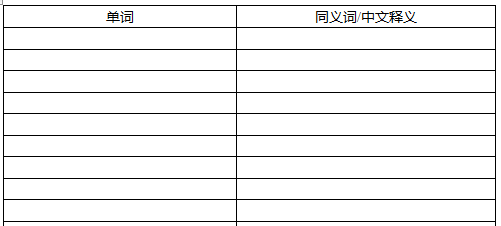托福阅读常考话题及练习题推荐三:艺术(1)
1托福阅读常考话题:艺术
Passage 3
Rock Art of the Australia Aborigines
Ever since European first explored Australia, people have been trying to understand the ancient rock drawings and carvings created by the Aborigines, the original inhabitants of the continent. Early in the nineteenth century, encounters with Aboriginal rock art tended to be infrequent and open to speculative interpretation, but since the late nineteenth century, awareness of the extent and variety of Australian rock art has been growing. In the latter decades of the twentieth century there were intensified efforts to understand and record the abundance of Australian rock art.
The systematic study of this art is a relatively new discipline in Australia. Over the past four decades new discoveries have steadily added to the body of knowledge. The most significant data have come from a concentration on three major questions. First, what is the age of Australian rock art? Second, what is its stylistic organization and is it possible to discern a sequence or a pattern of development between styles? Third, is it possible to interpret accurately the subject matter of ancient rock art, bring to bear all available archaeological techniques and the knowledge of present-day Aboriginal informants?
The age of Australia’s rock art is constantly being revised, and earlier datings have been proposed as the result of new discoveries. Currently, reliable scientific evidence dates the earliest creation of art on rock surfaces in Australia to somewhere between 30,000 and 50,000 years ago. This in itself is an almost incomprehensible span of generations, and one that makes Australia’s rock art the oldest continuous art tradition in the world.
Although the remarkable antiquity of Australia’s rock art is now established, the sequences and meanings of its images have been widely debated. Since the mid-1970s, a reasonably stable picture has formed of the organization of Australian rock art. In order to create a sense of structure to this picture, researchers have relied on a distinction that still underlies the forms of much indigenous visual culture—a distinction between geometric and figurative elements. Simple geometric repeated patterns—circles, concentric circles, and lines—constitute the iconography (characteristic images) of the earliest rock-art sites found across Australia. The frequency with which certain simple motifs appear in these oldest sites has led rock-art researchers to adopt a descriptive term—the Panaramitee style—a label which takes its name from the extensive rock pavements at Panaramitee North in desert South Australia, which are covered with motifs pecked into the surface. Certain features of these engravings lead to the conclusion that they are of great age—geological changes had clearly happened after the designs had been made and local Aboriginal informants, when first questioned about them, seemed to know nothing of their origins. Furthermore, the designs were covered with “desert varnish,” a glaze that develops on rock surfaces over thousands of years of exposure to the elements. The simple motifs found at Panaramitee are common to many rock-art sites across Australia. Indeed, sites with engravings of geometric shapes are also to be found on the island of Tasmania, which was separated from the mainland of the continent some 10,000 years ago.
In the 1970s when the study of Australian archaeology was in an exciting phase of development, with the great antiquity of rock art becoming clear. Lesley Maynard, the archaeologist who coined the phrase “Panaramitee style,” suggested that a sequence could be determined for Australian rock art, in which a geometric style gave way to a simple figurative style (outlines of figures and animals), followed by a range of complex figurative styles that, unlike the pan-Australian geometric tradition, tended to much greater regional diversity. While accepting that this sequence fits the archaeological profile of those sites, which were occupied continuously over many thousands of years a number of writers have warned that the underlying assumption of such a sequence—a development from the simple and the geometric to the complex and naturalistic—obscures the cultural continuities in Aboriginal Australia, in which geometric symbolism remains fundamentally important. In this context the simplicity of a geometric motif may be more apparent than real. Motifs of seeming simplicity can encode complex meanings in Aboriginal Australia. And has not twentieth-century art shown that naturalism does not necessarily follow abstraction in some kind of predetermine sequence?
2托福阅读常考话题:艺术练习题
【段落主旨】
Paragraph 1:
Paragraph 2:
Paragraph 3:
Paragraph 4:
【生词摘录】

托福阅读课程中心
查看更多 >- 托福入门36小时 新航道成都学校托福入门... 托福基础培训班,成都托福基础班,成都托福基础培训班,托福入门培训班,成都托福入门班,成都托福基础培训班 在线咨询
- 托福精讲72小时 新航道成都学校托福精讲... 托福强化培训班,成都托福强化,成都托福培训班,成都托福强化班,托福精讲培训,托福精讲培训课程,成都托福精讲培训,托福精讲阶段培训课程 在线咨询
- 托福“飞跃计划”套餐课程 成都新航道托福“飞跃计... 托福飞跃课程,成都托福培训,托福套餐课程 在线咨询
- 托福“卓越计划”套餐课程 成都新航道托福“卓越计... 托福卓越课程,成都托福培训,托福套餐课程 在线咨询
- 托福作文批改卡 成都新航道托福写作批改... 托福写作批改卡,成都托福写作,成都托福写作批改卡 在线咨询
- 成都托福一对一培训班 成都新航道托福一对一培... 成都托福1对1,成都托福一对一,成都托福一对一培训班,托福一对一培训班 在线咨询
托福快讯
- 托福线上培训课程如何选机构 2024-02-27
- 出国留学申请需要托福成绩... 2023-07-06
- 托福考试费用托福考试一次... 2023-06-14
- 成都托福5月考试报名时间... 2023-04-23
- 托福考试中出现的常见问题... 2023-02-14

